William Henry Bartlett
William Henry Bartlett (March 26, 1809 – September 13, 1854) was a British artist, best known for his numerous drawings rendered into steel engravings.
William Henry Bartlett | |
|---|---|
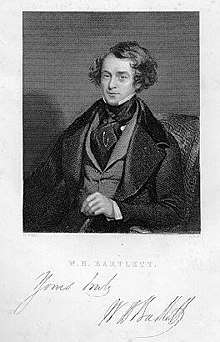 Self portrait of W H Bartlett, from the cover of his book Working A Canoe Up A Rapid. | |
| Born | March 26, 1809 |
| Died | September 13, 1854 (aged 45) |
| Nationality | British |
| Known for | Steel engraving |
Biography
Bartlett was born in Kentish Town, London in 1809. He was apprenticed to John Britton (1771–1857), and became one of the foremost illustrators of topography of his generation. He travelled throughout Britain, and in the mid and late 1840s he travelled extensively in the Balkans and the Middle East. He made four visits to North America between 1836 and 1852.
In 1835, Bartlett first visited the United States to draw the buildings, towns and scenery of the northeastern states. The finely detailed steel engravings Bartlett produced were published uncolored with a text by Nathaniel Parker Willis as American Scenery; or Land, Lake, and River: Illustrations of Transatlantic Nature. American Scenery was published by George Virtue in London in 30 monthly installments from 1837 to 1839. Bound editions of the work were published from 1840 onward.[1] In 1838 Bartlett was in the Canadas producing sketches for Willis' Canadian scenery illustrated, published in 1842. Following a trip to the Middle East, he published Walks about the city and environs of Jerusalem in 1840.
Bartlett made sepia wash drawings the exact size to be engraved. His engraved views were widely copied by artists, but no signed oil painting by his hand is known. Engravings based on Bartlett's views were later used in his posthumous History of the United States of North America, continued by Bernard Bolingbroke Woodward and published around 1856.
Bartletts primary concern was to render "lively impressions of actual sights", as he wrote in the preface to The Nile Boat (London, 1849). Many views contain some ruin or element of the past including many scenes of churches, abbeys, cathedrals and castles, and Nathaniel Parker Willis described Bartlett's talent thus: "Bartlett could select his point of view so as to bring prominently into his sketch the castle or the cathedral, which history or antiquity had allowed".
Bartlett returning from his last trip to the Near East suddenly took ill and died of fever on board the French steamer Egyptus off the coast of Malta in 1854.[2][3] His widow Susanna lived for almost 50 years after his death, and died in London on 25 October 1902, aged 91.[4]
Works
.jpg)
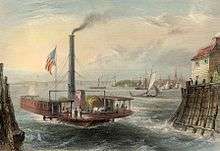
.jpg)
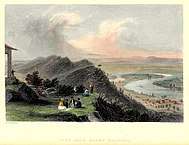 View from Mount Holyoke (Massachusetts). The Oxbow, Connecticut River, 1835
View from Mount Holyoke (Massachusetts). The Oxbow, Connecticut River, 1835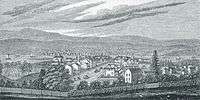 City of Hudson, NY, 1837
City of Hudson, NY, 1837 Citadel of Kingston. Ink print. 1839—1842.
Citadel of Kingston. Ink print. 1839—1842.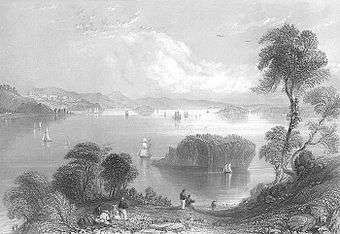 Eastport and Passamaquoddy Bay, 1839
Eastport and Passamaquoddy Bay, 1839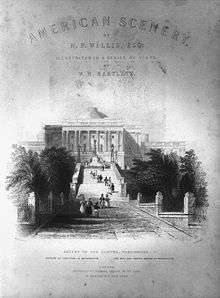 American Scenery by N. P. Willis, 1840
American Scenery by N. P. Willis, 1840 Interior of the house of a Christian family in Jerusalem, ca 1850
Interior of the house of a Christian family in Jerusalem, ca 1850 Fair at Khan al-Tujjar, ca 1850
Fair at Khan al-Tujjar, ca 1850
 Meeting of the Waters, Avoca River, Ireland
Meeting of the Waters, Avoca River, Ireland
References
- The Nathaniel Parker Willis Papers: American Scenery, 1837-1839 Subscription publication in 30 parts describing travels around America
- "Died: W. H. Bartlett, Esq". London: The Morning Chronicle. 27 Sep 1854. p. 8. Retrieved 27 May 2020.
Died: On the 13th inst., in his passage to Marseille, on board the French steamer Egyptus
- "Death of W. H. Bartlett". Edinburgh, Scotland: The Caledonian Mercury. 2 Oct 1854. p. 2. Retrieved 27 May 2020.
Mr Bartlett's last visit, to the East was undertaken only a few months ago, with the express design of inspecting some ancient remains, and of furnishing a series of illustrations for a new work on the subject. But on his return from that hallowed ground, he was taken suddenly ill on board the French steamer ‘’Egyptus’’, and in the course of the following day expired in the prime of life., and when almost in sight of land.
- "Deaths". The Times (36910). London. 28 October 1902. p. 1.
External links
| Wikimedia Commons has media related to William Henry Bartlett. |
- Engravings by Bartlett
- Bartlett Prints in the collection of the Niagara Falls Public Library (Ont.)
- William H. Bartlett Prints, 1837-1842, a finding aid to a New York State Library collection of copies of some of Bartlett's prints.
- Bartlett, W. H. in CAPITAL COLLECTIONS
- Biography at the Dictionary of Canadian Biography Online
- Works by William Henry Bartlett at Project Gutenberg
- Works by William Henry Bartlett (illustrator) at Faded Page (Canada)
- Works by or about William Henry Bartlett at Internet Archive